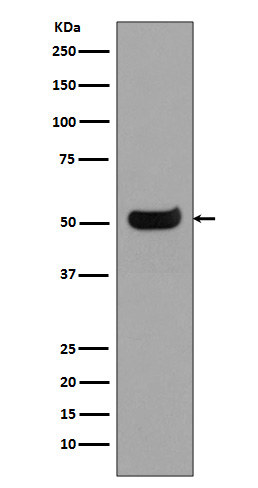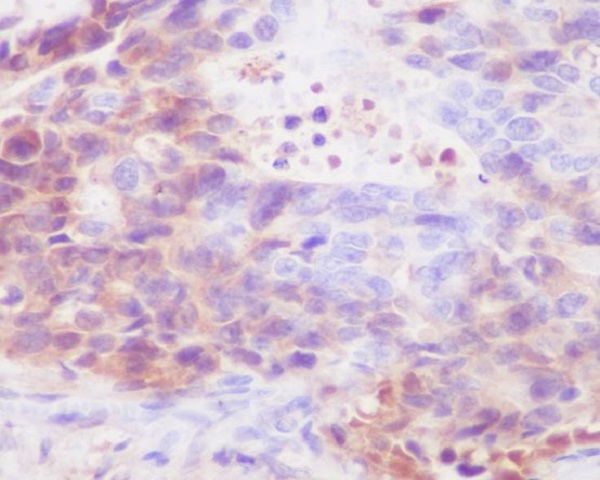

| WB | 1/500-1/1000 | Human,Mouse,Rat |
| IF | 咨询技术 | Human,Mouse,Rat |
| IHC | 1/50-1/100 | Human,Mouse,Rat |
| ICC | 技术咨询 | Human,Mouse,Rat |
| FCM | 咨询技术 | Human,Mouse,Rat |
| Elisa | 咨询技术 | Human,Mouse,Rat |
| Aliases | IGG4; Ig gamma 4 chain C region |
| Entrez GeneID | 3503 |
| WB Predicted band size | Calculated MW: 36 kDa; Observed MW: 36 kDa |
| Host/Isotype | Rabbit IgG |
| Antibody Type | Primary antibody |
| Storage | Store at 4°C short term. Aliquot and store at -20°C long term. Avoid freeze/thaw cycles. |
| Species Reactivity | Human |
| Immunogen | A synthesized peptide derived from human IgG4 |
| Formulation | Purified antibody in PBS with 0.05% sodium azide. |
+ +
以下是3篇关于人IgG4抗体的关键文献及其摘要概括:
---
1. **文献名称**:*"Anti-inflammatory activity of human IgG4 antibodies by dynamic Fab arm exchange"*
**作者**:van der Neut Kolfschoten, M. et al. (2007)
**摘要**:研究发现IgG4抗体可通过Fab-arm交换形成双特异性抗体,失去交联抗原的能力,从而减弱免疫反应。这种独特特性使其在慢性抗原暴露中发挥抗炎作用。
---
2. **文献名称**:*"Immunoglobulin G4: an odd antibody"*
**作者**:Aalberse, R.C. & Schuurman, J. (2002)
**摘要**:系统总结了IgG4的生物学特性,包括其低补体激活能力、与Fc受体结合弱等特点,并探讨了其在过敏性疾病和寄生虫感染中的双重免疫调节作用。
---
3. **文献名称**:*"IgG4-related disease: an emerging clinical paradigm"*
**作者**:Stone, J.H. et al. (2012)
**摘要**:综述了IgG4相关疾病(IgG4-RD)的病理特征,指出患者组织中IgG4+浆细胞浸润和纤维化现象,强调IgG4可能通过非典型炎症途径驱动组织损伤。
---
4. **文献名称**:*"The immunoglobulin IgG4 exerts specific immunosuppressive effects in the cancer microenvironment"*
**作者**:Dahan, R. et al. (2016)
**摘要**:揭示IgG4抗体在肿瘤微环境中通过竞争性结合Fcγ受体,抑制效应T细胞功能,从而削弱PD-1/PD-L1抑制剂疗效,提示其在癌症免疫治疗中的潜在负面影响。
---
这些文献分别从结构特性、免疫调节、疾病机制及治疗应用角度解析了IgG4抗体的复杂生物学行为。
Human IgG4 is one of the four subclasses of immunoglobulin G (IgG) in humans, characterized by unique structural and functional properties. It constitutes approximately 3-6% of total IgG in serum. Structurally, IgG4 has a shorter hinge region and asymmetric disulfide bonds, leading to "half-antibody" formation and dynamic Fab-arm exchange—a process where IgG4 molecules swap antigen-binding arms, creating bispecific antibodies. This behavior reduces immune complex formation, contributing to its anti-inflammatory role.
IgG4 exhibits weak binding to Fcγ receptors and complement components, limiting effector functions like phagocytosis or complement-dependent cytotoxicity. This makes IgG4 a poor activator of inflammatory responses, often associated with immune tolerance. Elevated IgG4 levels are observed in chronic antigen exposure (e.g., allergies, parasitic infections) and IgG4-related diseases, a fibroinflammatory condition marked by tissue infiltration of IgG4-positive plasma cells.
In therapeutics, IgG4 is used for engineering monoclonal antibodies (e.g., nivolumab) due to its reduced inflammatory side effects. However, its Fab-arm exchange can compromise efficacy, prompting structural modifications to stabilize molecules. Paradoxically, IgG4 antibodies may also play roles in immune evasion in cancers or interfere with diagnostic assays by blocking pathogenic autoantibodies.
Overall, IgG4's dual nature—balancing immune modulation and pathogenic potential—makes it a critical focus in immunology research and therapeutic development.
×